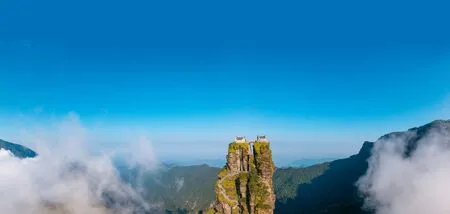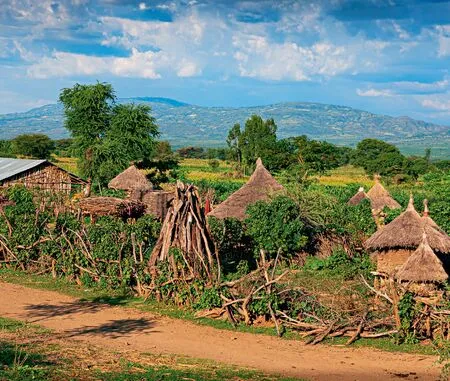orld Heritage
YEAR OF INSCRIPTION 2018
CHINA Fanjingshan (Fanjing Mountain)
The Fanjingshan World Heritage property is located in southwest China, covering a total area of 40,275 hectares, fully enclosed by a buffer zone of 37,239 hectares.Fanjingshan is located in a monsoonal climatic context and is an important source of water for the surrounding landscapes and beyond, with some 20 rivers and streams feeding the Wujiang and Yuanjiang river systems, both of which ultimately drain into the Yangtze River.
The property consists of two parts,namely the Jian Nan subtropical evergreen forests ecoregion (64 percent)and the Guizhou Plateau broadleaf and mixed forests ecoregion (36 percent).The highest peak, Fenghuangshan, has an elevation of 2,570 metres above sea level and the property covers an altitudinal range of more than 2,000 metres.The resulting vertical stratification of vegetation falls within three major altitudinal vegetation zones: evergreen broadleaf forest, mixed evergreen and deciduous broadleaf forest and mixed deciduous broadleaf and conifer and scrub forest.
Fanjingshan is an island of metamorphic rock in a sea of karst and is home to many ancient and relict plant and animal species which originated in the Tertiary Period, between 65 million and 2 million years ago. The property’s geologic and climatic characteristics have shaped its flora which behaves as if it were on an island.
A total of 3,724 plant species have been recorded in the property, an impressive 13 percent of China’s total flora. The property is characterised by an exceptionally high richness in bryophytes as well as one of the distribution centres for gymnosperms in China. The diversity of invertebrates is also very high with 2,317 species. A total of 450 vertebrate species are found inside the property.

An aerial view of Fanjingshan

Traditional Ethiopian village in Lower Valley of the Omo
YEAR OF INSCRIPTION 1980
ETHIOPIA Lower Valley of the Omo
The Lower Valley of the Omo is located in southwest Ethiopia. It extends over an area of 165 square km. The age old sedimentary deposits in the Lower Omo Valley are now world renowned for the discovery of many hominid fossils that have been of fundamental importance in the study of human evolution.
The Lower Omo Valley includes the Konso and Fejej paleontological research locations with sedimentary deposit going back to the plio-pleistocene period.These have produced numerous hominid and animal fossils, including fragments of Australopithecus. The deposits of human vertebrae fauna, and paleoenvironmental evolution, shed light on the earliest stages of the origins and development of Homo sapiens of Africa.The discoveries of ancient stone tools in an encampment also offer evidence of the oldest known technical activities of prehistoric beings, thus making the property one of the most significant for mankind.
To ensure Omo’s position as the yardstick against which all other ancient deposits in East Africa are measured,researched evidence from the site has established bio-stratigraphical, radiometric and magneto-stratigraphical scales spanning between 1 million and 3.5 million years.
Since 1966, scientific research has proved that the site significantly contributes to prominent archaeological,geological, paleo-anthropological and paleo-environmental studies. CA

